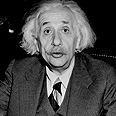
Albert Einstein
צילום: Gettyimages Imagebank
Einstein's relativity manuscript goes on display in Israel
Handwritten explanation of general theory of relativity being shown at Israel Academy of Sciences and Humanities in Jerusalem. Professor: I refer to it as the Magna Carta of physics
The original manuscript of Albert Einstein's groundbreaking theory of relativity, which helps explain everything from black holes to the Big Bang, went on display Sunday in its entirety for the first time.
Einstein's 46-page handwritten explanation of his general theory of relativity, in which he demonstrates an expanding universe and shows how gravity can bend space and time, is being shown at the Israel Academy of Sciences and Humanities in Jerusalem as part the scholarly association's 50th anniversary celebration.
"We wanted something unique that would have global significance, and fortunately we could have access to a manuscript that has never been seen in its entirety before," said the academy's president, Menahem Yaari.
Einstein was one of the founders of the Hebrew University in Jerusalem.
He contributed the manuscript to the university when it was founded in 1925, four years after he was awarded the Nobel Prize in physics. His will bequeathed the rest of his papers to the university upon his death in 1955.
The university is lending the manuscript to the academy for the anniversary celebration.
First published in 1916, the general theory of relativity remains a pivotal breakthrough in modern physics.
"It changed our understanding of space, time, gravitation, and really the entire universe," said Hanoch Gutfreund, former president of the Hebrew University and current chair of its academic committee for the Albert Einstein Archives, a complete collection of Einstein's papers.
"I refer to it as the Magna Carta of physics," Gutfreund said. "It's the most important manuscript in the entire archives."
'People will be able to appreciate this'
Despite its central place in the canon of Einstein's work, the original manuscript has never attracted as much attention as the man himself.
According to Gutfreund, museums around the world have been content to display only a few pages of the manuscript at a time, as part of larger features on the personal and professional accomplishments of perhaps the modern era's most influential scientist.
That is partly because the contents of the general theory, especially in the original German, remain a bit obscure for nonscientists.
It took Einstein eight years after publishing his theory of special relativity — in which he came up with the famed equation EMC2 (squared) — to expand that into his theory of general relativity, in which he showed that gravity can affect space and time, a key to understanding basic forces of physics and natural phenomena, including the origin of the universe.
But exhibit organizers say the significance of Einstein's pages of careful script, diagrams, and perfectionist's scratches will not be lost on casual viewers. They say the display will present the manuscript in the context of the theory's legacy — which includes everything from modern space exploration to commercial satellite and GPS technology and present-day attempts to create a universal explanation of the forces of nature, a quest that started decades ago and stymied even Einstein himself.
"The greatest challenge at the frontier of physics is to make progress on these issues, the ideas that Einstein developed, discarded, and the errors he made," Gutfreund said. "People will be able to appreciate this even if they're not able to understand the contents."
The manuscript will be on display until March 25, overlapping with the 131st anniversary of Einstein's birth on March 14.










